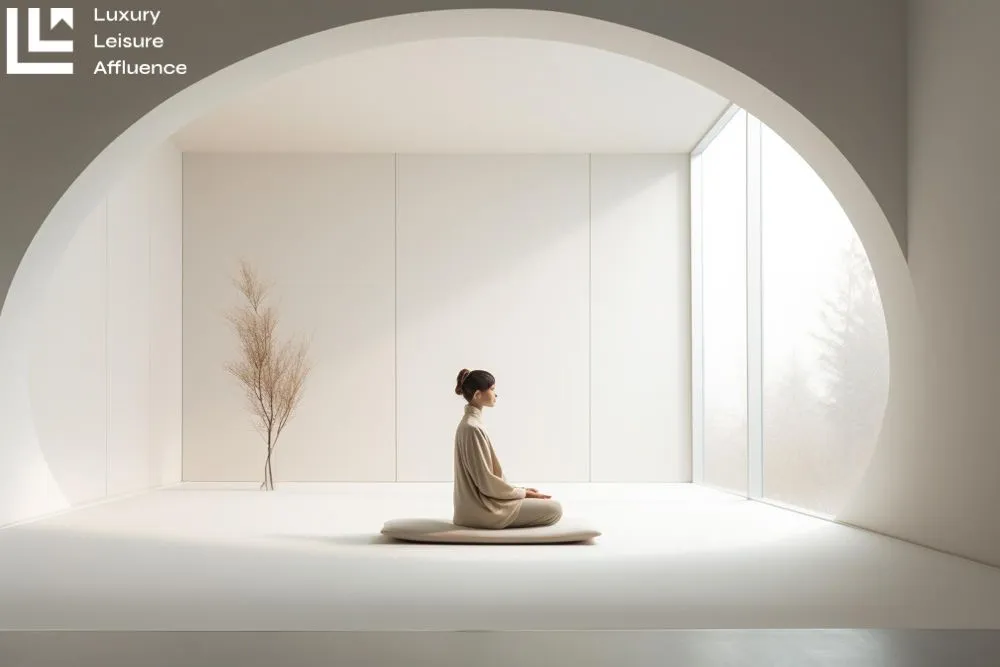Updated On: March 07, 2024 by Yasmin Elwan
Amidst the relentless hustle and bustle of city life, where the quest for a moment’s peace often seems like a distant dream, we stand united. We have all borne the weight of this challenge in our own lives—immersing ourselves in studies and reflections in pursuit of the rare luxury of silence. Our efforts have revealed something quite heartening: pockets of calm do indeed thrive amid urban sprawl; they’re sanctuaries within our reach, promising repose within the frenetic tapestry of city sounds.
Let us guide you on this journey towards tranquillity—the stillness you crave might just be tucked around the corner.
What is Considered a Quiet Space in a Busy City?
Finding peace and quiet in busy city environments is crucial for mental well-being. However, achieving total silence in urban areas can be challenging due to constant noise pollution.
Importance of finding peace and quiet in busy cities
We recognise how the relentless pace of city life can leave us feeling drained and on edge. Stepping into a quiet space gives us the opportunity to unwind, reflect, and restore our inner calm. In the midst of towering buildings and endless traffic, these havens become pockets where time slows down and one can hear their own thoughts. Silence is no longer just an absence but transforms into a presence that enriches our lives.
Our modern cities teem with noise pollution, which chips away at our mental clarity and health. By championing silent spaces, we take a stand against this invisible intruder. We embrace tranquillity as an essential element for well-being, creating urban sanctuaries that allow our minds to roam freely without distraction. For us in bustling metropolises, finding these oases becomes not just important but necessary for sustaining balance in our lives.
Is total silence achievable in urban environments?
Creating total silence in urban environments presents a significant challenge, given the constant presence of noise from various sources. However, engineers and designers are working towards achieving this goal by creating areas with minimal acoustical complexity. While complete silence may be elusive, the establishment of zones and refuges with reduced noise levels can provide individuals with a sense of tranquillity amidst the urban chaos.
The concept of silence as a luxury product reflects its rarity in today’s noisy cities, where finding spaces devoid of disruptive sounds is increasingly valuable for mental and physical well-being. Certified quiet places, such as those promoted by Quiet Parks International (QPI), aim to offer individuals an escape from urban noise pollution by providing serene environments within cities or their immediate vicinity.
The Price of Noise
The constant noise in urban environments takes a toll on our mental health and well-being, leading to decreased productivity and overall quality of life. It’s important to consider the impact of noise on our daily lives and how we can mitigate its effects.
Effects of constant noise on mental health
Excessive noise in urban settings contributes to a range of negative impacts on mental health. Studies have shown that constant exposure to high levels of noise can lead to increased stress, anxiety, and irritability. It can disrupt sleep patterns, leading to fatigue and decreased cognitive function. The World Health Organisation (WHO) has identified noise pollution as a significant environmental risk factor for both mental and physical health issues, making the creation of quiet spaces within cities essential for residents’ well-being.
Persistent exposure to urban noise has been associated with heightened levels of cortisol, the body’s primary stress hormone. This prolonged elevation of cortisol levels can contribute to conditions such as hypertension, cardiovascular disease, and weakened immune function over time.
Negative impact on productivity and well-being
The constant exposure to noise in urban environments can have a detrimental effect on individuals’ productivity and overall well-being. Studies have shown that excessive noise can lead to increased stress levels, reduced cognitive function, and disrupted sleep patterns.
This, in turn, impacts individuals’ ability to focus, concentrate, and perform at their best in work or daily tasks. The negative impact of noise on mental health also extends to physical well-being, as it is linked to an increase in the risk of heart disease, high blood pressure, and other health issues.
Furthermore, the presence of noise pollution in urban areas has been found to contribute significantly to decreased job satisfaction and overall quality of life for city dwellers. The inability to escape from constant noise can lead to feelings of frustration, irritability, and fatigue—factors that directly affect individuals’ motivation and enthusiasm for work or other activities.
The Luxury of Silence
In the hustle and bustle of urban life, silence has become a rare luxury. Its exclusivity and appeal make it a coveted commodity in noisy urban landscapes, leading to the emergence of certified quiet places, sound baths, and sophisticated low-key luxury designs aimed at providing the elusive presence of real quiet.
Silence as a luxury product
Amidst the clamour of modern urban life, silence has emerged as a coveted luxury item. The elusive commodity of real quiet is becoming increasingly scarce and valuable in today’s noisy urban environments. The concept of silence as a luxury good is gaining recognition, with individuals seeking solace and peace in exclusive soundproof sanctuaries. As an advocate for silence, Gordon Hempton defines true quiet as the presence of everything rather than an absence of sound.
The appeal lies in providing individuals with a serene and peaceful environment, away from the chaotic pace of city living. With cities grappling with increasing noise pollution, the demand for sophisticated, low-key luxury designs that offer respite from bustling urban landscapes continues to rise. This shift prompts architects, urban planners, and sound experts to explore innovative ways to incorporate tranquillity into future structures and spaces.
Its exclusivity and appeal
Silence is no longer just an absence of noise; it has become a scarce and exclusive commodity, particularly in the urban jungle. The increasing clamour of city life has elevated silence to a luxury product sought after by those seeking solace amidst the chaos.
This shift in perspective has made silent retreats and certified quiet places more appealing, creating a demand for architecture and design focused on reducing noise and promoting wellness. As urban environments continue to grow louder, the appeal of these serene oases becomes even more pronounced.
Ways to Create Quiet Spaces in Busy Cities

Creating quiet spaces in urban busy cities requires a thoughtful and multifaceted approach that considers various factors such as location, design elements, community engagement, and urban planning strategies.
Collaboration between engineers, designers, and planners
Engineers, designers, and planners collaborate to create innovative solutions for quiet spaces in bustling cities. Their combined expertise ensures the integration of soundproofing materials and architectural design to mitigate noise pollution effectively. This collaborative effort aims to incorporate serene enclaves within urban areas, offering residents a reprieve from the constant din. By designing meditation rooms and sound baths, these professionals contribute to the promotion of mental wellness in noisy city environments.
The cooperation between engineers, designers, and planners plays a pivotal role in crafting future urban landscapes that prioritise serenity and tranquillity. Through strategic planning and innovative architectural design, they work towards establishing certified quiet places that cater to the growing need for peaceful retreats within bustling metropolises.
How to Create a Quiet Space in a Busy City
To establish quiet spaces in bustling urban areas, a meticulous approach is essential. Here’s a concise guide to creating tranquil spaces within city environments:
Choosing Suitable Locations
Starting with the identification of potential sites within the city where quiet spaces can be developed is crucial. These locations may include underutilised parks, vacant lots, waterfront areas, or unused urban pockets. Consider proximity to residential neighbourhoods, public transportation access, and existing noise levels when selecting sites.
Thorough assessments of noise levels in these selected locations are necessary to comprehend the extent of noise pollution and pinpoint areas with the greatest need for quiet spaces. This may involve using noise monitoring equipment or collaborating with experts in acoustics and urban planning to analyse noise data.
Design Considerations
- Layout and Configuration: Design the layout of quiet spaces to maximise tranquillity and minimise exposure to noise from surrounding areas. Consider incorporating features such as winding pathways, secluded alcoves, and natural barriers to create intimate and peaceful environments.
- Landscaping and Greenery: Integrate lush landscaping, greenery, and vegetation into the design to provide visual interest, absorb sound, and create a buffer against noise pollution. Trees, shrubs, and green walls can help mitigate noise while enhancing the aesthetic appeal of the space.
- Water Features: Incorporate water features such as fountains, ponds, or streams, which not only add a soothing auditory element but also help mask urban noise and create a calming atmosphere.
- Materials and Surfaces: Select materials and surfaces that minimise sound reflection and absorption. Use soft, porous materials like grass, gravel, wood, or rubberised surfaces for pathways and seating areas to dampen noise and create a more comfortable environment.
Community Engagement
Local residents, stakeholders, and community groups should be involved in the planning and design process to ensure that quiet spaces meet the needs and preferences of the community. Public meetings, workshops, or surveys can be conducted to gather input, solicit feedback, and generate ideas for the design and programming of the space.
Programming and Activities
A variety of programming and activities within quiet spaces can attract visitors and promote engagement. Options may include yoga classes, meditation sessions, outdoor concerts, art installations, or educational workshops focused on mindfulness and well-being.
Accessibility and Inclusivity
It’s important to guarantee that quiet spaces are accessible and inclusive to individuals of all ages, abilities, and backgrounds. This involves integrating universal design principles to accommodate individuals with disabilities and offering amenities such as seating areas, restrooms, and shade structures to enhance comfort and convenience.
Maintenance and Management
A comprehensive maintenance and management plan should be developed to guarantee the long-term sustainability and upkeep of quiet spaces. This might entail regular landscaping, trash removal, graffiti prevention, and safety inspections to uphold a clean, safe, and inviting environment for visitors.
Policy and Regulation
Advocacy for supportive policies and regulations at the local government level is essential to prioritise the creation and preservation of quiet spaces in urban planning efforts. This could encompass advocating for zoning ordinances, noise abatement policies, and funding mechanisms to support the development and maintenance of quiet spaces within the city.
Benefits of Quiet Spaces

Quiet spaces in busy cities offer a myriad of benefits, from reduced stress levels and improved mental health to increased productivity and better overall well-being. These sanctuaries provide a much-needed respite from the hustle and bustle of urban life, allowing individuals to recharge and find inner peace amidst the chaos.
Mental Well-being
Quiet spaces provide a retreat from the constant sensory stimulation and noise pollution of urban environments. This respite allows individuals to relax, unwind, and recharge, ultimately promoting mental well-being and reducing stress levels. Studies have shown that spending time in quiet environments can improve mood, increase focus, and enhance overall cognitive function.
Physical Health
Chronic exposure to noise pollution has been linked to various adverse health effects, including cardiovascular problems, sleep disturbances, and heightened stress levels. Quiet spaces offer a reprieve from these negative impacts, allowing individuals to experience lower blood pressure, improved sleep quality, and reduced levels of cortisol, the stress hormone.
Social Connection
Quiet spaces provide opportunities for social interaction and community engagement in a tranquil setting. Whether it’s enjoying a peaceful walk with a friend, participating in a meditation class, or simply sitting quietly with loved ones, these spaces foster meaningful connections and promote a sense of belonging within the community.
Creativity and Reflection
Silence and solitude are conducive to introspection, creativity, and self-reflection. Quiet spaces offer individuals the chance to disconnect from the distractions of modern life and tap into their inner thoughts, ideas, and inspirations. Whether it’s journaling, sketching, or simply contemplating the surrounding environment, these spaces encourage personal growth and self-discovery.
Environmental Benefits
Many quiet spaces are designed with an emphasis on greenery, natural elements, and sustainable practices. Not only do these features contribute to the aesthetic appeal of the space, but they also provide tangible environmental benefits such as improved air quality, increased biodiversity, and enhanced ecosystem services. Additionally, quiet spaces serve as valuable urban oases for wildlife, supporting biodiversity conservation efforts in densely populated areas.
Overall, the creation of quiet spaces within busy cities is an essential pursuit for enhancing the well-being and mental health of urban residents. Collaborative efforts from engineers, designers, and planners are crucial in establishing areas that offer respite from constant noise. As silence becomes increasingly scarce in urban environments, the concept of quiet spaces as a luxury commodity gains significance. The establishment of certified quiet places by organisations such as Quiet Parks International aims to provide individuals with much-needed solitude and peace amidst the hustle and bustle of city life.











